Reflective Essay on Biased Treatment in Healthcare (CNA157)
VerifiedAdded on 2022/10/02
|8
|2112
|22
Essay
AI Summary
This reflective essay examines the pervasive issue of biased treatment within healthcare, focusing on the experiences of the LGBTQ+ population. The essay begins by defining intersectionality and reflecting on the author's own cultural location in Tasmania, highlighting the discrimination faced by LGBTQ+ individuals in various aspects of life. The author then reflects on how their personal values and beliefs, shaped by their cultural background, influence their approach to patient care. The essay delves into culturally safe practices, such as self-awareness, acknowledgement, and empathy, that can be adopted to mitigate unconscious biases and ensure equitable treatment. Furthermore, the essay outlines strategies for advocating for patients, including fostering an inclusive environment and educating others on bias. The author emphasizes the importance of cultural competency training and the protection of patient privacy. The essay concludes by underscoring the significance of addressing biased treatment and promoting a more inclusive and equitable healthcare system for all, and provides several references to support the arguments made in the essay.
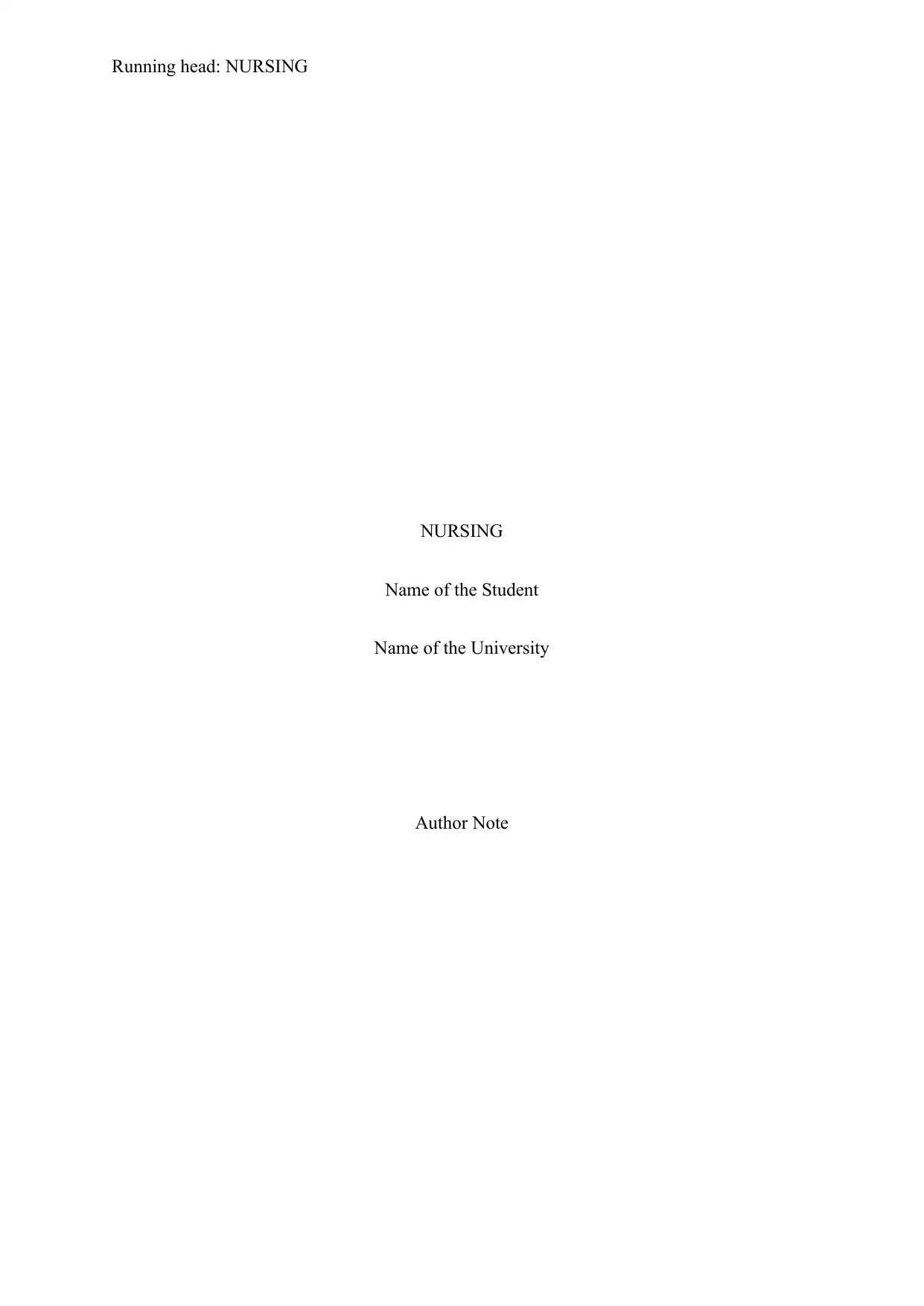
Running head: NURSING
NURSING
Name of the Student
Name of the University
Author Note
NURSING
Name of the Student
Name of the University
Author Note
Paraphrase This Document
Need a fresh take? Get an instant paraphrase of this document with our AI Paraphraser
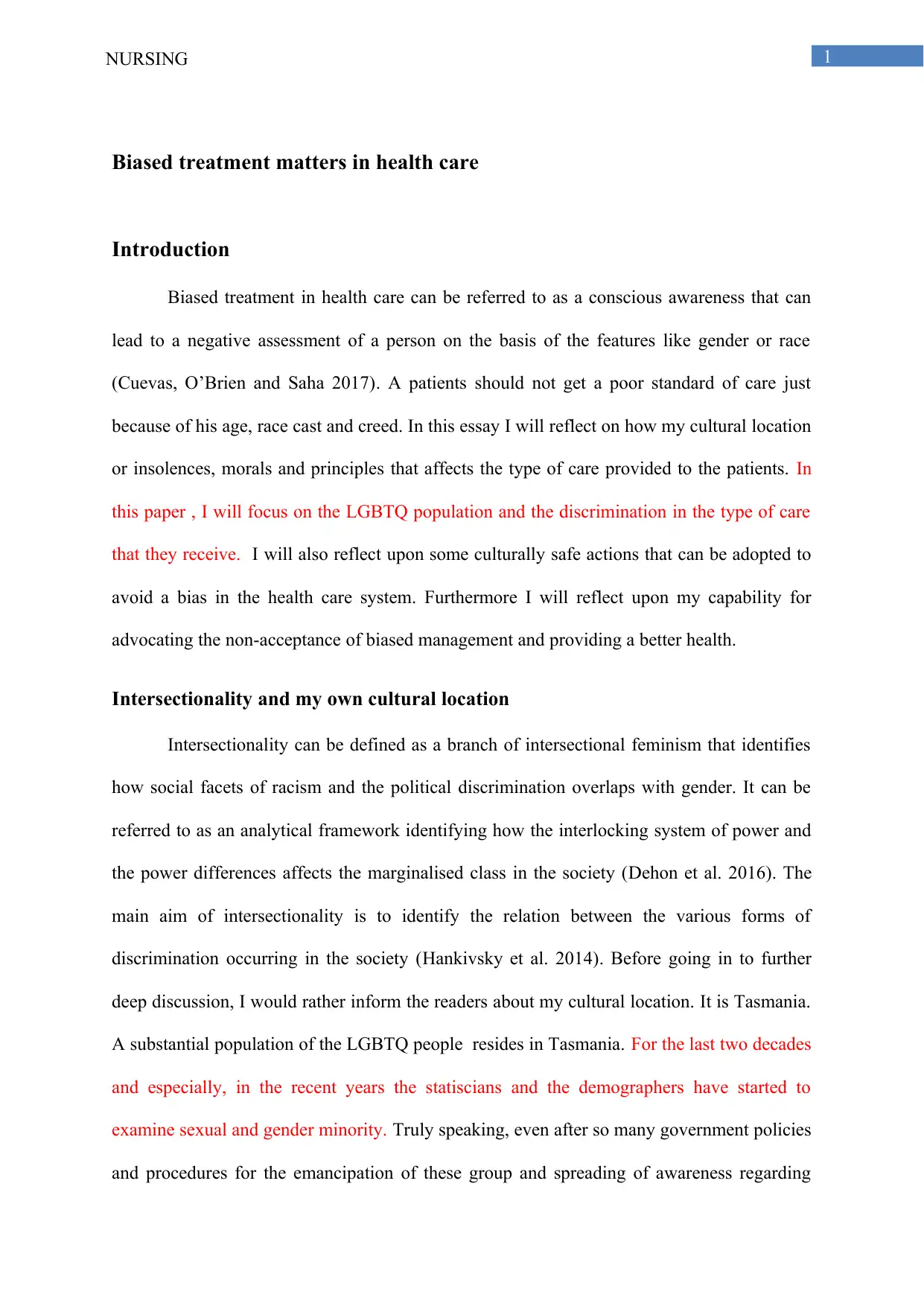
1NURSING
Biased treatment matters in health care
Introduction
Biased treatment in health care can be referred to as a conscious awareness that can
lead to a negative assessment of a person on the basis of the features like gender or race
(Cuevas, O’Brien and Saha 2017). A patients should not get a poor standard of care just
because of his age, race cast and creed. In this essay I will reflect on how my cultural location
or insolences, morals and principles that affects the type of care provided to the patients. In
this paper , I will focus on the LGBTQ population and the discrimination in the type of care
that they receive. I will also reflect upon some culturally safe actions that can be adopted to
avoid a bias in the health care system. Furthermore I will reflect upon my capability for
advocating the non-acceptance of biased management and providing a better health.
Intersectionality and my own cultural location
Intersectionality can be defined as a branch of intersectional feminism that identifies
how social facets of racism and the political discrimination overlaps with gender. It can be
referred to as an analytical framework identifying how the interlocking system of power and
the power differences affects the marginalised class in the society (Dehon et al. 2016). The
main aim of intersectionality is to identify the relation between the various forms of
discrimination occurring in the society (Hankivsky et al. 2014). Before going in to further
deep discussion, I would rather inform the readers about my cultural location. It is Tasmania.
A substantial population of the LGBTQ people resides in Tasmania. For the last two decades
and especially, in the recent years the statiscians and the demographers have started to
examine sexual and gender minority. Truly speaking, even after so many government policies
and procedures for the emancipation of these group and spreading of awareness regarding
Biased treatment matters in health care
Introduction
Biased treatment in health care can be referred to as a conscious awareness that can
lead to a negative assessment of a person on the basis of the features like gender or race
(Cuevas, O’Brien and Saha 2017). A patients should not get a poor standard of care just
because of his age, race cast and creed. In this essay I will reflect on how my cultural location
or insolences, morals and principles that affects the type of care provided to the patients. In
this paper , I will focus on the LGBTQ population and the discrimination in the type of care
that they receive. I will also reflect upon some culturally safe actions that can be adopted to
avoid a bias in the health care system. Furthermore I will reflect upon my capability for
advocating the non-acceptance of biased management and providing a better health.
Intersectionality and my own cultural location
Intersectionality can be defined as a branch of intersectional feminism that identifies
how social facets of racism and the political discrimination overlaps with gender. It can be
referred to as an analytical framework identifying how the interlocking system of power and
the power differences affects the marginalised class in the society (Dehon et al. 2016). The
main aim of intersectionality is to identify the relation between the various forms of
discrimination occurring in the society (Hankivsky et al. 2014). Before going in to further
deep discussion, I would rather inform the readers about my cultural location. It is Tasmania.
A substantial population of the LGBTQ people resides in Tasmania. For the last two decades
and especially, in the recent years the statiscians and the demographers have started to
examine sexual and gender minority. Truly speaking, even after so many government policies
and procedures for the emancipation of these group and spreading of awareness regarding
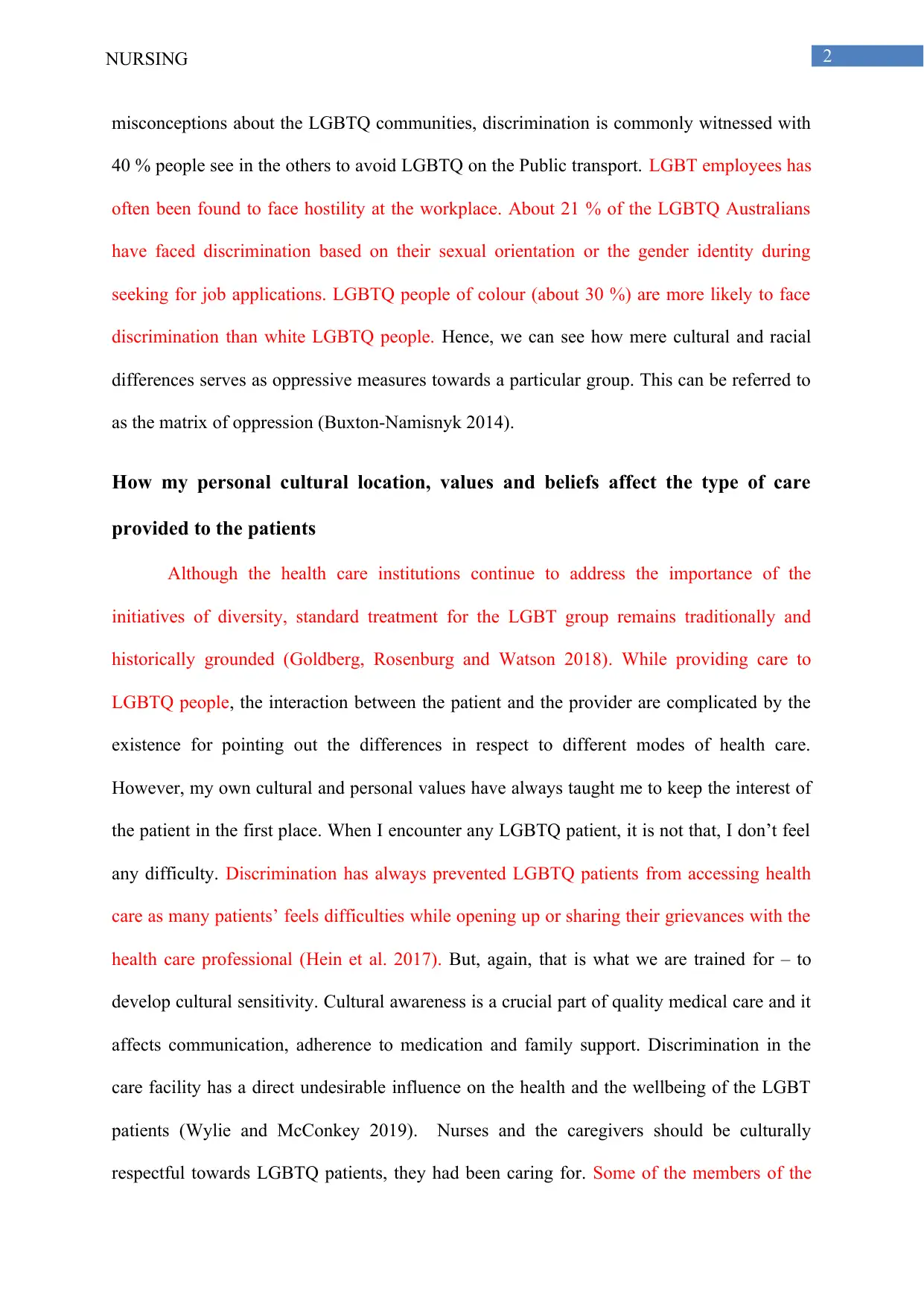
2NURSING
misconceptions about the LGBTQ communities, discrimination is commonly witnessed with
40 % people see in the others to avoid LGBTQ on the Public transport. LGBT employees has
often been found to face hostility at the workplace. About 21 % of the LGBTQ Australians
have faced discrimination based on their sexual orientation or the gender identity during
seeking for job applications. LGBTQ people of colour (about 30 %) are more likely to face
discrimination than white LGBTQ people. Hence, we can see how mere cultural and racial
differences serves as oppressive measures towards a particular group. This can be referred to
as the matrix of oppression (Buxton-Namisnyk 2014).
How my personal cultural location, values and beliefs affect the type of care
provided to the patients
Although the health care institutions continue to address the importance of the
initiatives of diversity, standard treatment for the LGBT group remains traditionally and
historically grounded (Goldberg, Rosenburg and Watson 2018). While providing care to
LGBTQ people, the interaction between the patient and the provider are complicated by the
existence for pointing out the differences in respect to different modes of health care.
However, my own cultural and personal values have always taught me to keep the interest of
the patient in the first place. When I encounter any LGBTQ patient, it is not that, I don’t feel
any difficulty. Discrimination has always prevented LGBTQ patients from accessing health
care as many patients’ feels difficulties while opening up or sharing their grievances with the
health care professional (Hein et al. 2017). But, again, that is what we are trained for – to
develop cultural sensitivity. Cultural awareness is a crucial part of quality medical care and it
affects communication, adherence to medication and family support. Discrimination in the
care facility has a direct undesirable influence on the health and the wellbeing of the LGBT
patients (Wylie and McConkey 2019). Nurses and the caregivers should be culturally
respectful towards LGBTQ patients, they had been caring for. Some of the members of the
misconceptions about the LGBTQ communities, discrimination is commonly witnessed with
40 % people see in the others to avoid LGBTQ on the Public transport. LGBT employees has
often been found to face hostility at the workplace. About 21 % of the LGBTQ Australians
have faced discrimination based on their sexual orientation or the gender identity during
seeking for job applications. LGBTQ people of colour (about 30 %) are more likely to face
discrimination than white LGBTQ people. Hence, we can see how mere cultural and racial
differences serves as oppressive measures towards a particular group. This can be referred to
as the matrix of oppression (Buxton-Namisnyk 2014).
How my personal cultural location, values and beliefs affect the type of care
provided to the patients
Although the health care institutions continue to address the importance of the
initiatives of diversity, standard treatment for the LGBT group remains traditionally and
historically grounded (Goldberg, Rosenburg and Watson 2018). While providing care to
LGBTQ people, the interaction between the patient and the provider are complicated by the
existence for pointing out the differences in respect to different modes of health care.
However, my own cultural and personal values have always taught me to keep the interest of
the patient in the first place. When I encounter any LGBTQ patient, it is not that, I don’t feel
any difficulty. Discrimination has always prevented LGBTQ patients from accessing health
care as many patients’ feels difficulties while opening up or sharing their grievances with the
health care professional (Hein et al. 2017). But, again, that is what we are trained for – to
develop cultural sensitivity. Cultural awareness is a crucial part of quality medical care and it
affects communication, adherence to medication and family support. Discrimination in the
care facility has a direct undesirable influence on the health and the wellbeing of the LGBT
patients (Wylie and McConkey 2019). Nurses and the caregivers should be culturally
respectful towards LGBTQ patients, they had been caring for. Some of the members of the
⊘ This is a preview!⊘
Do you want full access?
Subscribe today to unlock all pages.

Trusted by 1+ million students worldwide
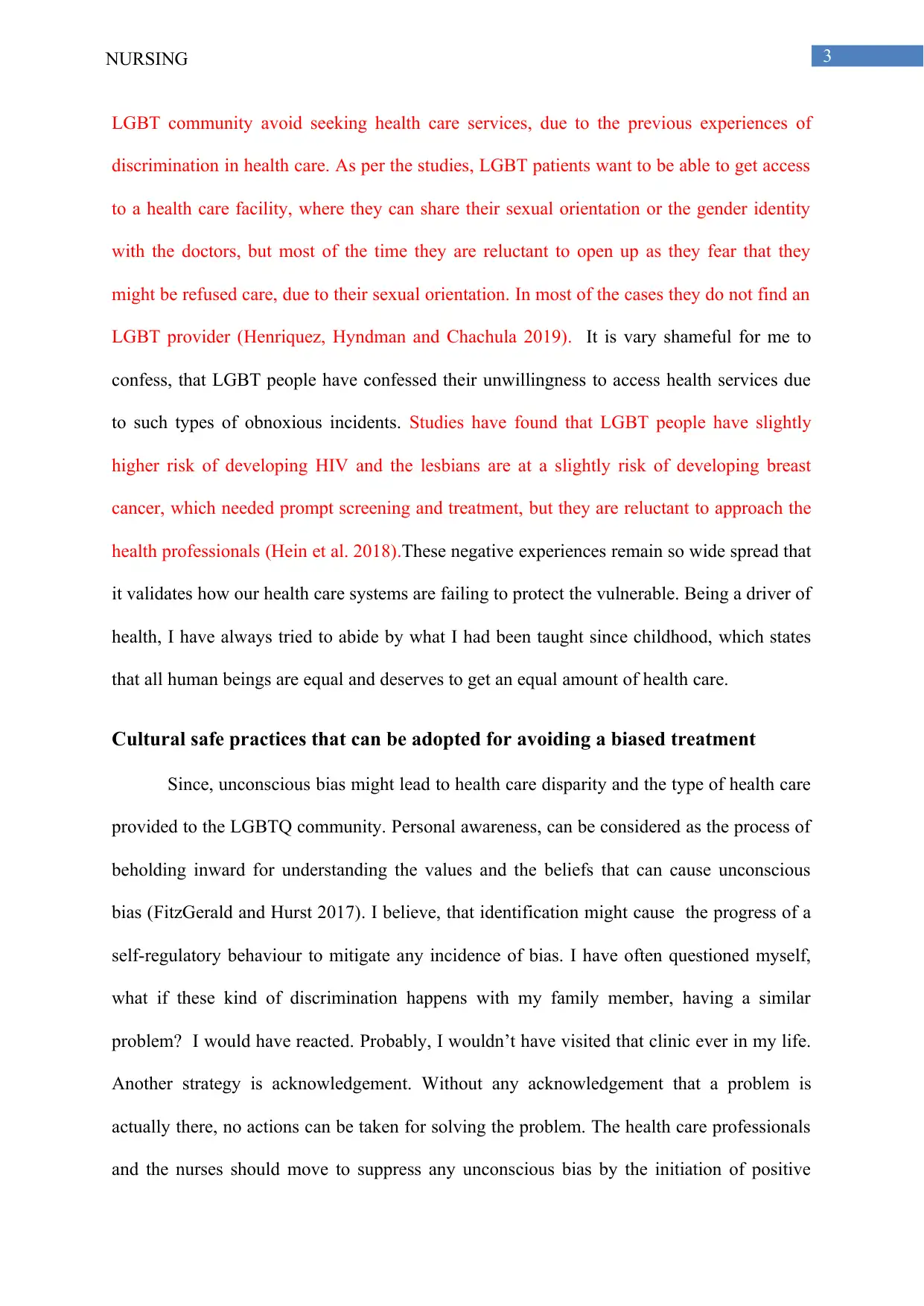
3NURSING
LGBT community avoid seeking health care services, due to the previous experiences of
discrimination in health care. As per the studies, LGBT patients want to be able to get access
to a health care facility, where they can share their sexual orientation or the gender identity
with the doctors, but most of the time they are reluctant to open up as they fear that they
might be refused care, due to their sexual orientation. In most of the cases they do not find an
LGBT provider (Henriquez, Hyndman and Chachula 2019). It is vary shameful for me to
confess, that LGBT people have confessed their unwillingness to access health services due
to such types of obnoxious incidents. Studies have found that LGBT people have slightly
higher risk of developing HIV and the lesbians are at a slightly risk of developing breast
cancer, which needed prompt screening and treatment, but they are reluctant to approach the
health professionals (Hein et al. 2018).These negative experiences remain so wide spread that
it validates how our health care systems are failing to protect the vulnerable. Being a driver of
health, I have always tried to abide by what I had been taught since childhood, which states
that all human beings are equal and deserves to get an equal amount of health care.
Cultural safe practices that can be adopted for avoiding a biased treatment
Since, unconscious bias might lead to health care disparity and the type of health care
provided to the LGBTQ community. Personal awareness, can be considered as the process of
beholding inward for understanding the values and the beliefs that can cause unconscious
bias (FitzGerald and Hurst 2017). I believe, that identification might cause the progress of a
self-regulatory behaviour to mitigate any incidence of bias. I have often questioned myself,
what if these kind of discrimination happens with my family member, having a similar
problem? I would have reacted. Probably, I wouldn’t have visited that clinic ever in my life.
Another strategy is acknowledgement. Without any acknowledgement that a problem is
actually there, no actions can be taken for solving the problem. The health care professionals
and the nurses should move to suppress any unconscious bias by the initiation of positive
LGBT community avoid seeking health care services, due to the previous experiences of
discrimination in health care. As per the studies, LGBT patients want to be able to get access
to a health care facility, where they can share their sexual orientation or the gender identity
with the doctors, but most of the time they are reluctant to open up as they fear that they
might be refused care, due to their sexual orientation. In most of the cases they do not find an
LGBT provider (Henriquez, Hyndman and Chachula 2019). It is vary shameful for me to
confess, that LGBT people have confessed their unwillingness to access health services due
to such types of obnoxious incidents. Studies have found that LGBT people have slightly
higher risk of developing HIV and the lesbians are at a slightly risk of developing breast
cancer, which needed prompt screening and treatment, but they are reluctant to approach the
health professionals (Hein et al. 2018).These negative experiences remain so wide spread that
it validates how our health care systems are failing to protect the vulnerable. Being a driver of
health, I have always tried to abide by what I had been taught since childhood, which states
that all human beings are equal and deserves to get an equal amount of health care.
Cultural safe practices that can be adopted for avoiding a biased treatment
Since, unconscious bias might lead to health care disparity and the type of health care
provided to the LGBTQ community. Personal awareness, can be considered as the process of
beholding inward for understanding the values and the beliefs that can cause unconscious
bias (FitzGerald and Hurst 2017). I believe, that identification might cause the progress of a
self-regulatory behaviour to mitigate any incidence of bias. I have often questioned myself,
what if these kind of discrimination happens with my family member, having a similar
problem? I would have reacted. Probably, I wouldn’t have visited that clinic ever in my life.
Another strategy is acknowledgement. Without any acknowledgement that a problem is
actually there, no actions can be taken for solving the problem. The health care professionals
and the nurses should move to suppress any unconscious bias by the initiation of positive
Paraphrase This Document
Need a fresh take? Get an instant paraphrase of this document with our AI Paraphraser
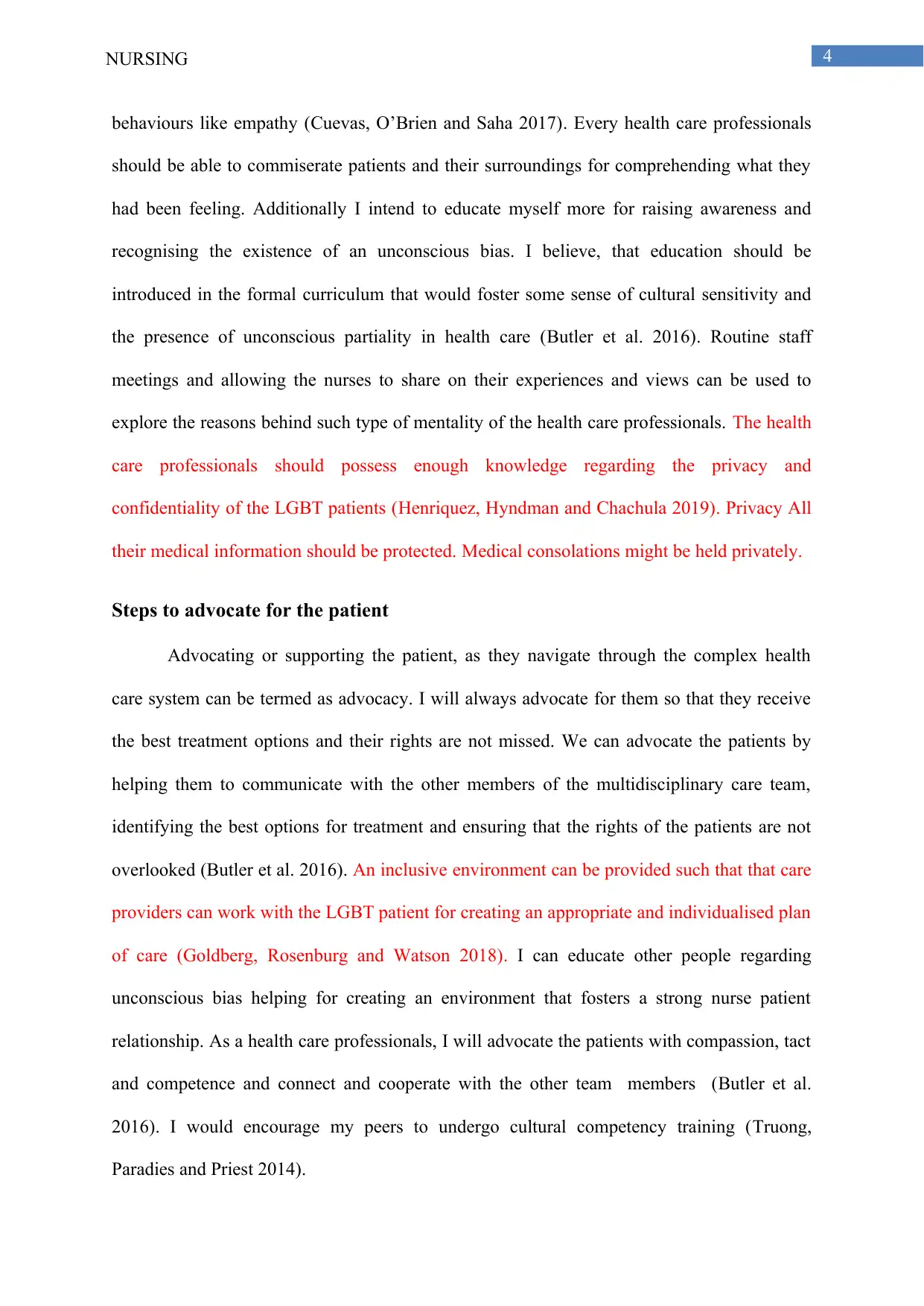
4NURSING
behaviours like empathy (Cuevas, O’Brien and Saha 2017). Every health care professionals
should be able to commiserate patients and their surroundings for comprehending what they
had been feeling. Additionally I intend to educate myself more for raising awareness and
recognising the existence of an unconscious bias. I believe, that education should be
introduced in the formal curriculum that would foster some sense of cultural sensitivity and
the presence of unconscious partiality in health care (Butler et al. 2016). Routine staff
meetings and allowing the nurses to share on their experiences and views can be used to
explore the reasons behind such type of mentality of the health care professionals. The health
care professionals should possess enough knowledge regarding the privacy and
confidentiality of the LGBT patients (Henriquez, Hyndman and Chachula 2019). Privacy All
their medical information should be protected. Medical consolations might be held privately.
Steps to advocate for the patient
Advocating or supporting the patient, as they navigate through the complex health
care system can be termed as advocacy. I will always advocate for them so that they receive
the best treatment options and their rights are not missed. We can advocate the patients by
helping them to communicate with the other members of the multidisciplinary care team,
identifying the best options for treatment and ensuring that the rights of the patients are not
overlooked (Butler et al. 2016). An inclusive environment can be provided such that that care
providers can work with the LGBT patient for creating an appropriate and individualised plan
of care (Goldberg, Rosenburg and Watson 2018). I can educate other people regarding
unconscious bias helping for creating an environment that fosters a strong nurse patient
relationship. As a health care professionals, I will advocate the patients with compassion, tact
and competence and connect and cooperate with the other team members (Butler et al.
2016). I would encourage my peers to undergo cultural competency training (Truong,
Paradies and Priest 2014).
behaviours like empathy (Cuevas, O’Brien and Saha 2017). Every health care professionals
should be able to commiserate patients and their surroundings for comprehending what they
had been feeling. Additionally I intend to educate myself more for raising awareness and
recognising the existence of an unconscious bias. I believe, that education should be
introduced in the formal curriculum that would foster some sense of cultural sensitivity and
the presence of unconscious partiality in health care (Butler et al. 2016). Routine staff
meetings and allowing the nurses to share on their experiences and views can be used to
explore the reasons behind such type of mentality of the health care professionals. The health
care professionals should possess enough knowledge regarding the privacy and
confidentiality of the LGBT patients (Henriquez, Hyndman and Chachula 2019). Privacy All
their medical information should be protected. Medical consolations might be held privately.
Steps to advocate for the patient
Advocating or supporting the patient, as they navigate through the complex health
care system can be termed as advocacy. I will always advocate for them so that they receive
the best treatment options and their rights are not missed. We can advocate the patients by
helping them to communicate with the other members of the multidisciplinary care team,
identifying the best options for treatment and ensuring that the rights of the patients are not
overlooked (Butler et al. 2016). An inclusive environment can be provided such that that care
providers can work with the LGBT patient for creating an appropriate and individualised plan
of care (Goldberg, Rosenburg and Watson 2018). I can educate other people regarding
unconscious bias helping for creating an environment that fosters a strong nurse patient
relationship. As a health care professionals, I will advocate the patients with compassion, tact
and competence and connect and cooperate with the other team members (Butler et al.
2016). I would encourage my peers to undergo cultural competency training (Truong,
Paradies and Priest 2014).

5NURSING
Conclusion
In conclusion , it can be said , that although the nurses and the other health care
professionals do not see themselves as biased, but is a persistent and a common problem that
is affecting the care services provided to the vulnerable individuals. My cultural location,
personal values affect the type of care provided by me, but in a positive way. Strategies like
introspection, acknowledgement, empathy, advocacy, community engagement, cultural
education and training can help to provide a better circumstances for the vulnerable group.
Conclusion
In conclusion , it can be said , that although the nurses and the other health care
professionals do not see themselves as biased, but is a persistent and a common problem that
is affecting the care services provided to the vulnerable individuals. My cultural location,
personal values affect the type of care provided by me, but in a positive way. Strategies like
introspection, acknowledgement, empathy, advocacy, community engagement, cultural
education and training can help to provide a better circumstances for the vulnerable group.
⊘ This is a preview!⊘
Do you want full access?
Subscribe today to unlock all pages.

Trusted by 1+ million students worldwide
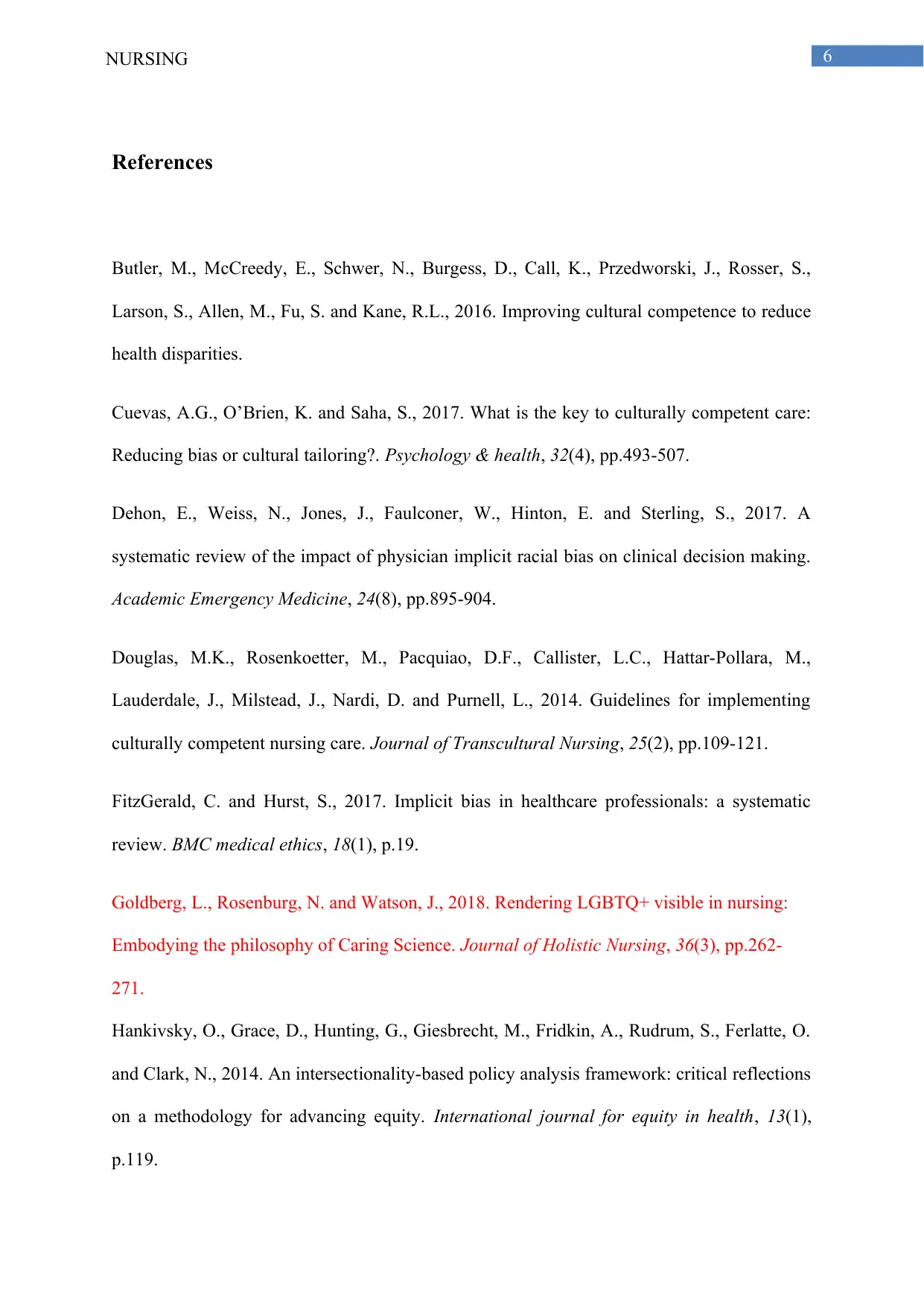
6NURSING
References
Butler, M., McCreedy, E., Schwer, N., Burgess, D., Call, K., Przedworski, J., Rosser, S.,
Larson, S., Allen, M., Fu, S. and Kane, R.L., 2016. Improving cultural competence to reduce
health disparities.
Cuevas, A.G., O’Brien, K. and Saha, S., 2017. What is the key to culturally competent care:
Reducing bias or cultural tailoring?. Psychology & health, 32(4), pp.493-507.
Dehon, E., Weiss, N., Jones, J., Faulconer, W., Hinton, E. and Sterling, S., 2017. A
systematic review of the impact of physician implicit racial bias on clinical decision making.
Academic Emergency Medicine, 24(8), pp.895-904.
Douglas, M.K., Rosenkoetter, M., Pacquiao, D.F., Callister, L.C., Hattar-Pollara, M.,
Lauderdale, J., Milstead, J., Nardi, D. and Purnell, L., 2014. Guidelines for implementing
culturally competent nursing care. Journal of Transcultural Nursing, 25(2), pp.109-121.
FitzGerald, C. and Hurst, S., 2017. Implicit bias in healthcare professionals: a systematic
review. BMC medical ethics, 18(1), p.19.
Goldberg, L., Rosenburg, N. and Watson, J., 2018. Rendering LGBTQ+ visible in nursing:
Embodying the philosophy of Caring Science. Journal of Holistic Nursing, 36(3), pp.262-
271.
Hankivsky, O., Grace, D., Hunting, G., Giesbrecht, M., Fridkin, A., Rudrum, S., Ferlatte, O.
and Clark, N., 2014. An intersectionality-based policy analysis framework: critical reflections
on a methodology for advancing equity. International journal for equity in health, 13(1),
p.119.
References
Butler, M., McCreedy, E., Schwer, N., Burgess, D., Call, K., Przedworski, J., Rosser, S.,
Larson, S., Allen, M., Fu, S. and Kane, R.L., 2016. Improving cultural competence to reduce
health disparities.
Cuevas, A.G., O’Brien, K. and Saha, S., 2017. What is the key to culturally competent care:
Reducing bias or cultural tailoring?. Psychology & health, 32(4), pp.493-507.
Dehon, E., Weiss, N., Jones, J., Faulconer, W., Hinton, E. and Sterling, S., 2017. A
systematic review of the impact of physician implicit racial bias on clinical decision making.
Academic Emergency Medicine, 24(8), pp.895-904.
Douglas, M.K., Rosenkoetter, M., Pacquiao, D.F., Callister, L.C., Hattar-Pollara, M.,
Lauderdale, J., Milstead, J., Nardi, D. and Purnell, L., 2014. Guidelines for implementing
culturally competent nursing care. Journal of Transcultural Nursing, 25(2), pp.109-121.
FitzGerald, C. and Hurst, S., 2017. Implicit bias in healthcare professionals: a systematic
review. BMC medical ethics, 18(1), p.19.
Goldberg, L., Rosenburg, N. and Watson, J., 2018. Rendering LGBTQ+ visible in nursing:
Embodying the philosophy of Caring Science. Journal of Holistic Nursing, 36(3), pp.262-
271.
Hankivsky, O., Grace, D., Hunting, G., Giesbrecht, M., Fridkin, A., Rudrum, S., Ferlatte, O.
and Clark, N., 2014. An intersectionality-based policy analysis framework: critical reflections
on a methodology for advancing equity. International journal for equity in health, 13(1),
p.119.
Paraphrase This Document
Need a fresh take? Get an instant paraphrase of this document with our AI Paraphraser

7NURSING
Hein, L.C., Stokes, F., Greenberg, C.S. and Saewyc, E.M., 2018. Policy brief: Protecting
vulnerable LGBTQ youth and advocating for ethical health care. Nursing outlook, 66(5),
pp.505-507.
Henriquez, N., Hyndman, K. and Chachula, K., 2019. It’s Complicated: Improving
Undergraduate Nursing Students’ Understanding Family and Care of LGBTQ Older Adults.
Journal of family nursing, p.1074840719864099.
Lim, F., Jones, P.A. and Paguirigan, M., 2019. A guide to fostering an LGBTQ-inclusive
workplace. Nursing management, 50(6), pp.46-53.
Truong, M., Paradies, Y. and Priest, N., 2014. Interventions to improve cultural competency
in healthcare: a systematic review of reviews. BMC health services research, 14(1), p.99.
Hein, L.C., Stokes, F., Greenberg, C.S. and Saewyc, E.M., 2018. Policy brief: Protecting
vulnerable LGBTQ youth and advocating for ethical health care. Nursing outlook, 66(5),
pp.505-507.
Henriquez, N., Hyndman, K. and Chachula, K., 2019. It’s Complicated: Improving
Undergraduate Nursing Students’ Understanding Family and Care of LGBTQ Older Adults.
Journal of family nursing, p.1074840719864099.
Lim, F., Jones, P.A. and Paguirigan, M., 2019. A guide to fostering an LGBTQ-inclusive
workplace. Nursing management, 50(6), pp.46-53.
Truong, M., Paradies, Y. and Priest, N., 2014. Interventions to improve cultural competency
in healthcare: a systematic review of reviews. BMC health services research, 14(1), p.99.
1 out of 8
Related Documents
Your All-in-One AI-Powered Toolkit for Academic Success.
+13062052269
info@desklib.com
Available 24*7 on WhatsApp / Email
![[object Object]](/_next/static/media/star-bottom.7253800d.svg)
Unlock your academic potential
Copyright © 2020–2025 A2Z Services. All Rights Reserved. Developed and managed by ZUCOL.



